Barracuda are one of the most exciting fish to catch. They fight extremely hard and can jump clear out of the water. These fish are typically in clear water which can make them leader shy. However, barracuda are very aggressive and will often bite if good bait is presented.
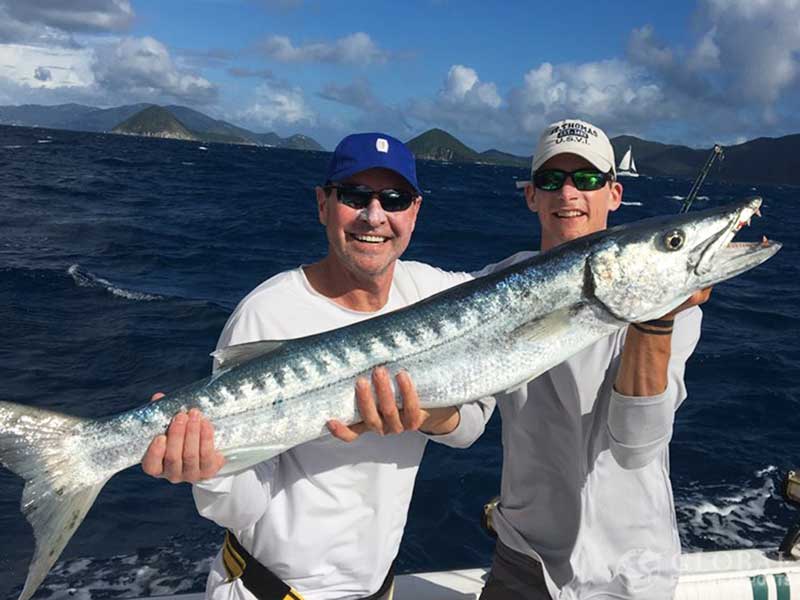
In the photo, we are holding up a large great barracuda one of my clients caught on a fishing trip in St. John in the United States Virgin Islands. This fish was caught using a live pilchard as bait. It was a windy day as you can see whitecap waves nearshore but big waves can equal big fish.
Barracuda Baits
Greenbacks
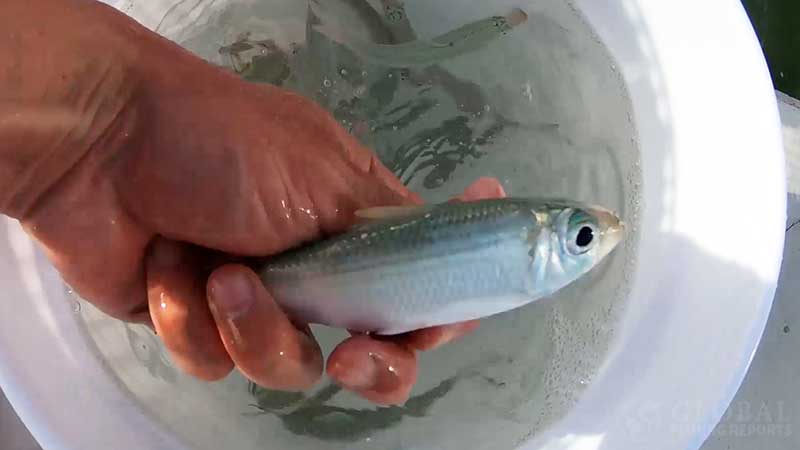
Live baits are a great way to catch barracuda. This is a photo of a bucket full of greenbacks caught on a sabiki rig. It is best to fish them on a thin wire leader for example number 4 wire which is a 38-pound test. The hooks should also be small and strong. Barracuda often are found in water that is crystal clear, offshore, or on a coral reef. If there is a thick leader the fish will see it and not bite because the fish are leader shy.
Live Bait
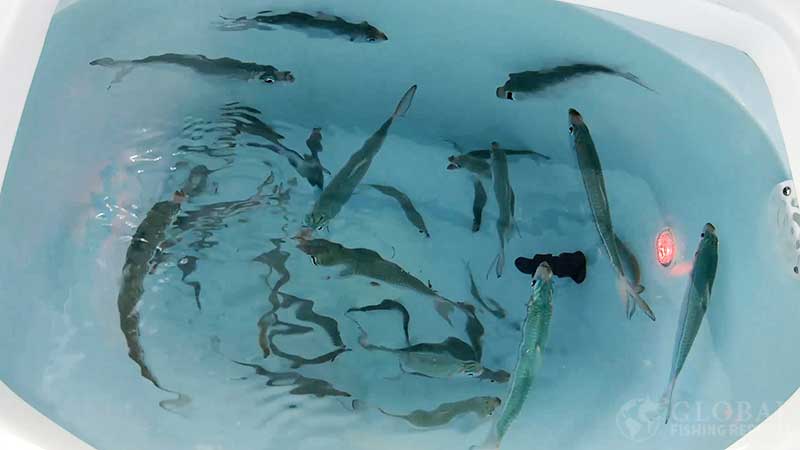
The photo is a livewell with greenbacks to use as live bait. Most live bait will work for barracuda and they even bite other fish that are being reeled in. I have had barracuda bite bonito, mahi-mahi, jacks, and yellowtail snapper while they are on the line. So most fish will work for bait just make sure the fish is a legal type of bait.
Dead bait will also work to catch barracuda. This is not how I try and catch them but they will often bite a tarpon bait which is a piece of mullet on a float. Barracuda will even bite shark rigs that have a chuck of barracuda for bait. Squid, ballyhoo, needlefish, and pinfish are also decent baits.
Goggle Eyes, Scaled Herring, and Pilchards
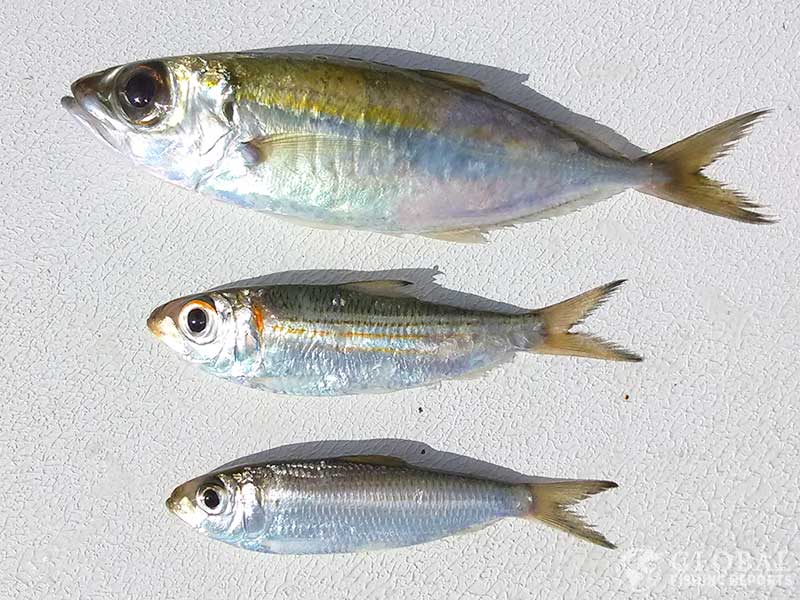
In the photo above are a goggle-eye, scaled sardine, and a pilchard. These are great live baits to use to catch lots of different types of fish.
In the video above I am fishing with my parents and nephews. My nephew hooks a giant barracuda that jumped many times. When it gets near the boat it jumps straight up at us and almost bites us. We caught the fish and safely released it. It was actually caught on a small shark rig with a piece of barracuda for bait.
Mullet
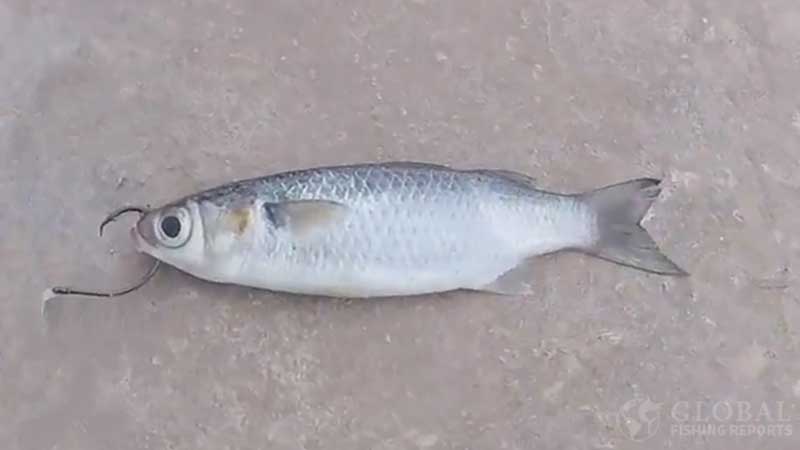
In the photo is a dead mullet that I was using for tarpon bait. Often times when I am fishing for tarpon I will catch barracuda as well. If you see a pod of mullet being attacked it is typically sharks, jacks, tarpon, or barracuda. If you think a fish with teeth will bite it is a good idea to use a think wire leader.
If there are lots of tarpon around then using an 80-pound fluorocarbon leader is a good fishing setup. Live or dead mullet work well to catch all types of fish. If the mullet is dead it is a good idea to cut off the tail and butterfly the fillets back. This will help release a lot of scent from the bait which can help encourage the fish to bite.
Barracuda For Bait
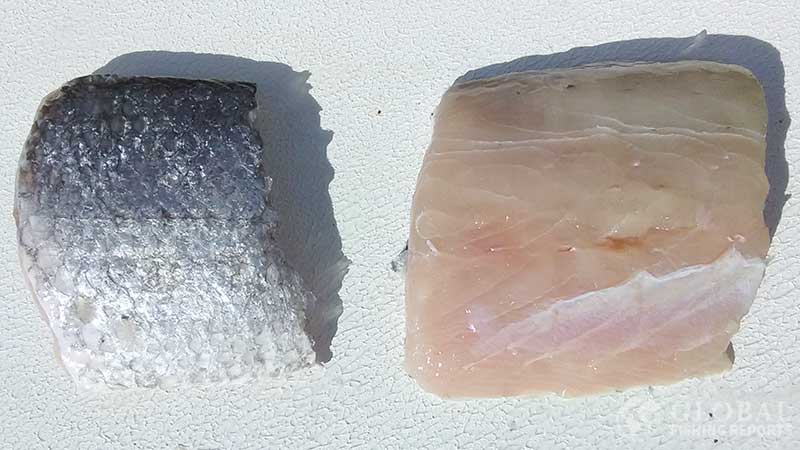
Barracuda is an awesome bait to use for most predator fish in the ocean. If I am using dead bait in the ocean it will most likely be mullet, ballyhoo, barracuda, or squid. The skin of the fillet is tough so it is very difficult for a fish to take it without getting hooked. Sometimes filefish will slowly eat it when fishing on the reef. Too many barracuda being used for bait is what led to the slot and daily bag limit being implemented in South Florida.
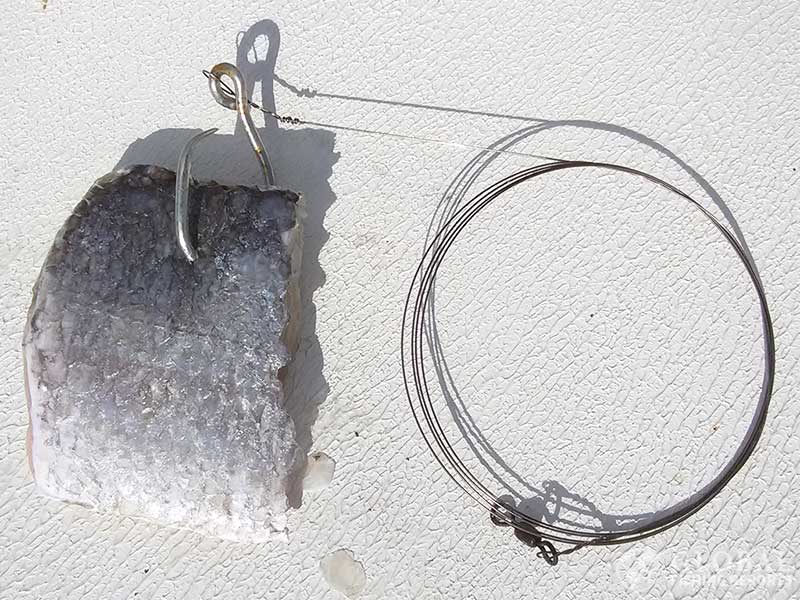
This is a picture of a shark rig with a piece of barracuda. This is hands down the best bait to use for sharks. If you place the hook through the meat and then the skin it is much easier to hook. The skin of a barracuda is tough and it is actually really hard to remove from the hook when you are done fishing. I will typically use a knife to cut the fillet off rather than trying to pull on the bait. This is a large stainless steel circle hook.
In Florida, stainless steel hooks are no longer allowed to be used for shark fishing. You can use coated carbon hooks. It is a good idea to scratch the carbon coating off the hooks so that it will rust if it is left in the shark. It is still a good idea to remove the hooks from fish when it can be done safely.
Barracuda Rigs
Wire Reef Rigs
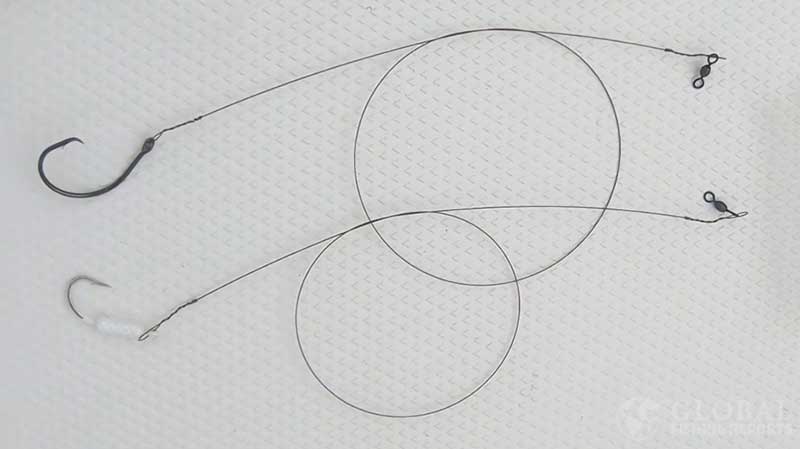
The rigs I use on the reef are a thin number 4 wire which is a 38-pound test. This is tied with a haywire twist to a small hook and small swivel. A small weighted jig can also be used to get the bait a bit deeper and off the surface. This is a great rig cause many fish including king mackerel, cero mackerel, wahoo, barracuda, and sharks all have teeth that will likely cut mono line. Barracuda can be caught on a monofilament line depending on where it gets hooked in the mouth and the thickness of the line. However, a good live bait in a thin wire is my go-to set up to catch barracuda.
In the video above I show how to tie a haywire twist. This is done with the number 4 wire and number 10 wire which has a 124-pound test. I will typically use number 10 wire for shark rigs. Barracuda will still bite this heavier leader from time to time but a thinner wire is a better option in most cases. There were times when I had barracuda eating the fish I was reeling in on thin mono. However, I soon as I put a similar baitfish down on heavy wire the fish will not bite. This is why using a thin wire with fresh live bait works the best.
Lures for Barracuda
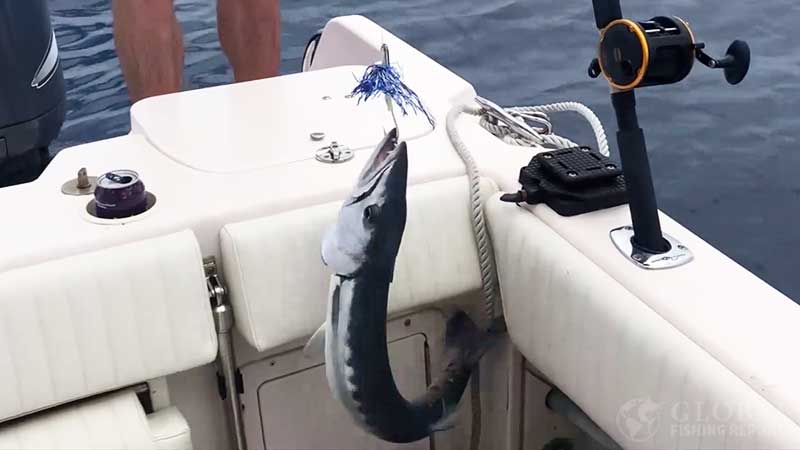
In the picture above is a barracuda my nephew caught on a billy bait offshore trolling lure. This fish was actually caught about 10 miles offshore in federal waters. We were trolling for wahoo or tuna and the barracuda bit instead. It is very common to catch barracuda when trolling with ballyhoo and other large offshore baits. Sometimes the teeth will cut the line but most of the time when an 80-plus pound line is used the fish can be caught. The line will be nicked and sliced so the leader line should be replaced near the lure.
When wahoo fishing heavy multistrand cable or wire is used and barracuda will still bite a fast-moving lure. For this reason, I very rarely put out a lure just to try and catch a barracuda. For the most part, they are a by-catch when fishing offshore. Inshore with light tackle I will target barracuda for fun. They are very similar to catching a huge northern pike or musky. Except they actually fight harder and can jump really high in the air when being reeled in.
If you are targeting barracuda spoons, cuda tubes, plugs, bucktail jigs, and paddle tails all work well. The key is to troll or retrieve the lure quickly. Barracuda are fast and like to chase down their prey. Since they are not typically being targeting barracuda can be thought of as a bonus fish catch. This is as long as they do not cut your line. Catching a large barracuda is similar to catching a tarpon as it will likely jump and put on a show.
Barracuda Teeth
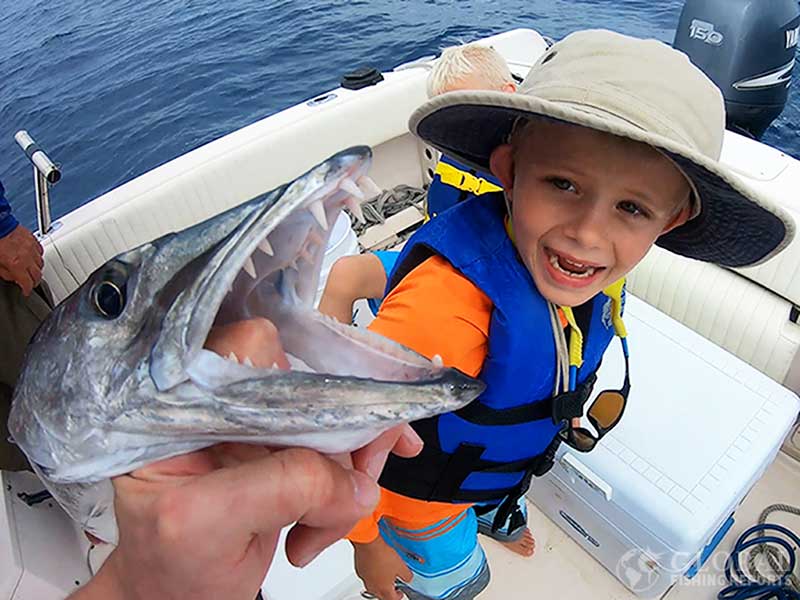
When you see a barracuda the first thing most people recognize are its large scary-looking teeth. These are not just for show either as these are razor sharp and can cut a fish in half with just one bite. Usually, the barracuda will bite down and thrash back and forth to cut into its larger prey.
When scuba diving and snorkeling with barracuda they are often curious and look intimidating. This is because they often linger around with their mouth open showing off their large teeth. In reality, they do not pose much threat to a diver as we are larger than what they eat. A barracuda should not be hand-fed and can mistake a watch, jewelry, or shiny object as bait and bite a human. I do not worry when I see a barracuda and typically see how close I can get to them when diving.
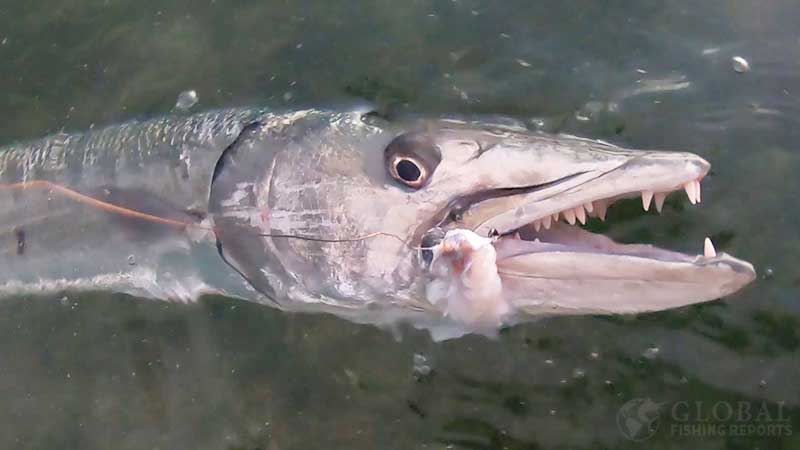
In the photo, you can see the large teeth of this adult great barracuda that was about 4 feet long. Also, you can see the bent wire leader that was used to catch the fish. The circle hook is in the corner of its mouth. For this reason, the teeth are not directly cutting into the line. However, as this fish jumped and thrashed around the line still likely hit the sharp teeth.
How Many Teeth
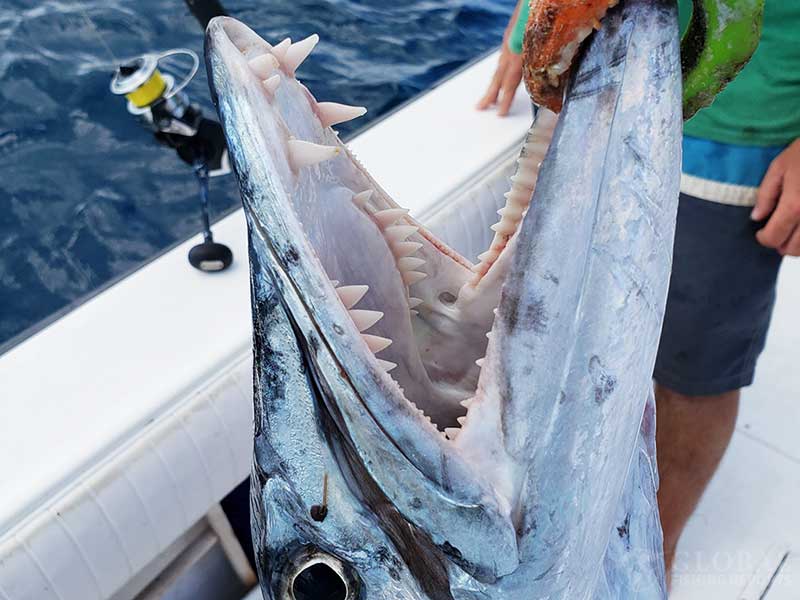
In this photo of the jaws of a barracuda, you can see three different types of teeth. The front jaw has 6 fang-like teeth on the upper jaw and 2 fang-like teeth on the lower jaw. The top middle row has around 16 large teeth and there are over 40 large teeth along the outside of the lower jaw. Finally, there are over 100 small pointy teeth along the outside upper jaw. Most adult barracuda will have over 150 teeth. It is common for some of the teeth to be broken or worn down.
The jawbone of a barracuda can be preserved. It is not a simple process though as some pieces of the jaws are connected with cartilage. When barracuda die naturally some of the teeth can be fossilized and found washed up on the beach similar to shark teeth.
Barracuda That Jump
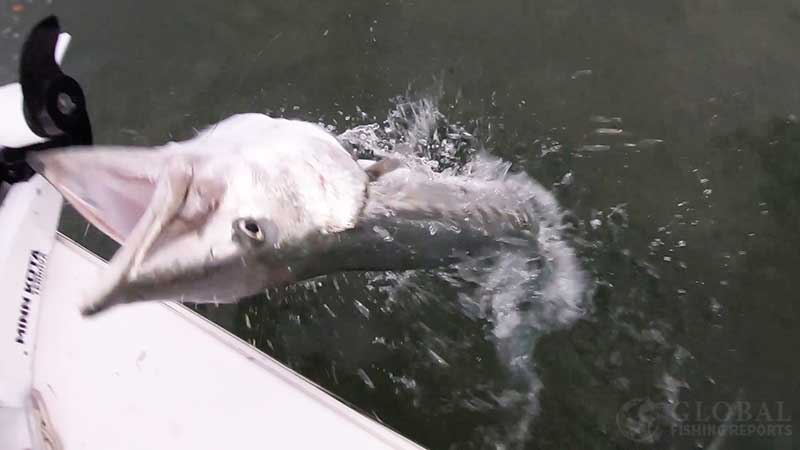
Barracuda are one of the fish that will jump clear out of the water when they are hooked. If it goes airborne it is probably a tarpon, ladyfish, mahi-mahi, marlin, or a barracuda. In the photo is a barracuda that jumped straight up toward my nephew and me. It was hooked but it was still unexpected for it to jump over the side of our flats boat. Luckily it landed back in the water.
I once knew a spot where a monster barracuda lived. It is actually common for barracuda to be on the same structure or spot on the reef day after day. I gave a stranger I met a mullet and told him where to cast. When I came back a few minutes later and his hands were shaking so much he could barely re-tie his took. He asked me what was that thing. ha ha It was a monster barracuda that launch clear out of the water. I hooked it a few times but never got the jumps on camera. It seriously was an incredible sight to see.
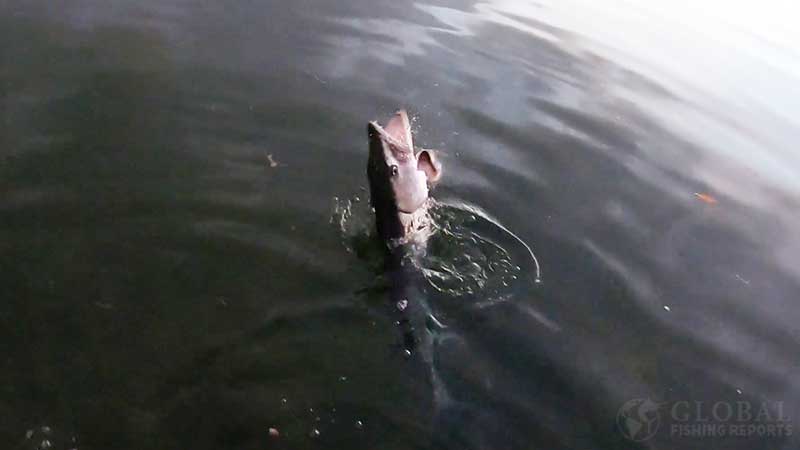
This barracuda is jumping and thrashing its head. When a tarpon jumps you are supposed to bow to the tarpon and give the line slack. I do not do this with barracuda as the hook usually stays in their mouth even if the line is tight when the fish jumps. It is a good idea to use a thin-wire circle hook. It can be a hook size from 3/0 to 9/0 depending on the size of the bait.
Barracuda Attacks
In the video above I am snorkeling with sharks, groupers, and barracuda. At one point I swim head to head with a large barracuda and it just swims away slowly. These fish can be aggressive toward other fish but are also prey for large groupers and sharks so they also try and keep their distance.
Barracuda will frequently attack and eat other fish. However, bites on humans are extremely rare. If a human does get bit it is most likely because the fish mistakes something a diver was wearing as a baitfish. It is important not to try and hand-feed these fish though as they can become aggressive and start looking for more food.
Size of Barracuda
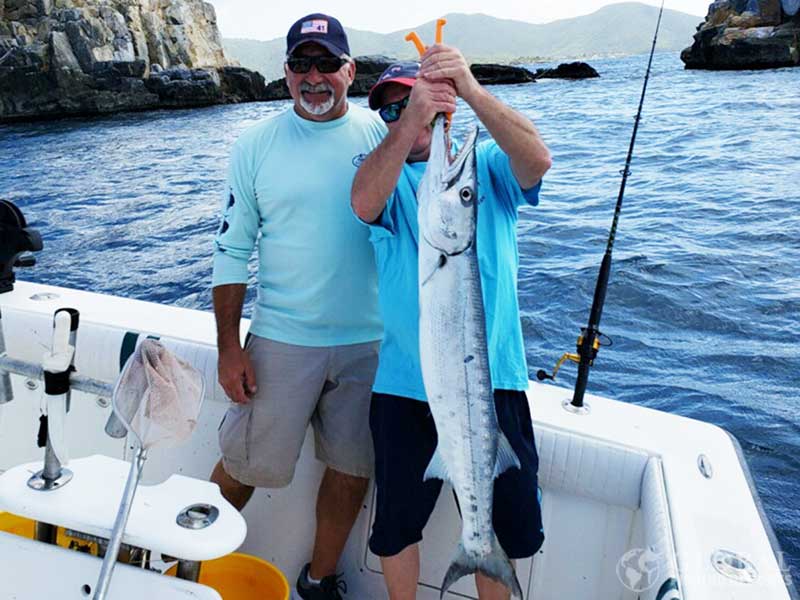
It is common to catch barracuda from 12 inches long to 4 feet long. If the fish are over 4 feet long or 30 pounds it is considered a large barracuda. The IGFA world record barracuda is 87 pounds 3 ounces. However, there has been barracuda caught over 102 pounds that had a length of 10 feet 7-inches long.
Barracuda can live to be over 14 years old. A research study in the Florida keys shows that males reached sexual maturity between 1-2 years old which corresponded to fork lengths of 24.6 inches to 31.7 inches. Females reached sexual maturity between 2-4 years old which corresponded to fork lengths of 27.9 inches to 38.8 inches.
Another barracuda research study showed that a 35.2-inch female has about 560,000 mature eggs and a 39.8-inch female has around 670,000 mature eggs. The fish will lay all of these eggs each spawning season. However, the female likely does not lay all the eggs at once but rather several times over the course of the 6-month spawning season.
Great Barracuda spawn in south Florida from the end of March to the middle of October. Barracuda can migrate northward in Florida in the spring and south in the fall. However, there is limited data showing this happens on a large scale. Barracuda of all sizes can be caught year-round in south Florida. Great barracuda will move around at different stages of their life. Barracuda can be found alone or in small groups on large coral reefs. In the Florida Keys I have even seen hundreds of adult barracua stacked up in a large school. This was likey during the breeding season.
Types of Barracuda
Great Barracuda
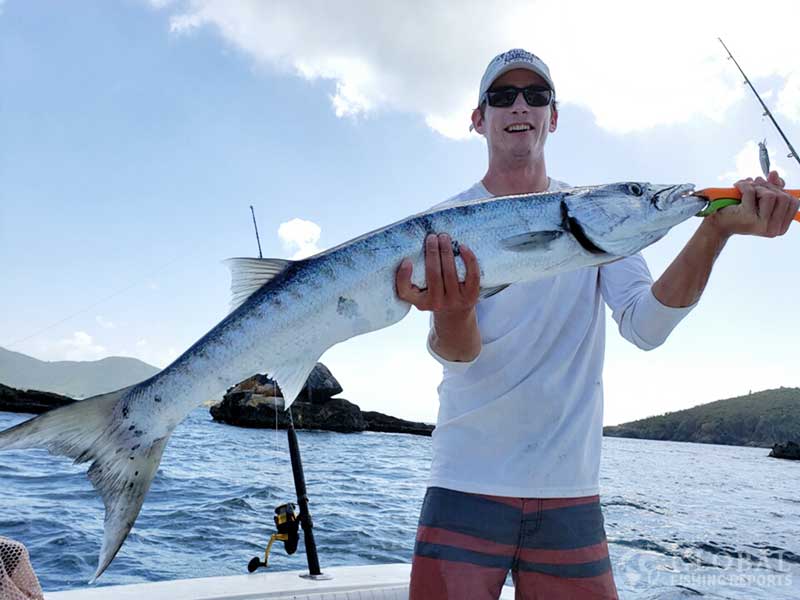
I am holding a great barracuda in the photo above. Notice I am holding the fish with a plastic lip gripper. This allows the mouth to be controlled while taking photos. Grabbing underneath the gill can put pressure on the gill which is not ideal. Also if you are holding under the gill the fish could slip more easily causing your hand to get bitten or cut by the teeth.
The great barracuda is what I think about when I think of Barracuda. These can be caught along the Atlantic coast of the United States, Gulf of Mexico, Caribbean Sea, along both coasts of Central America, and the upper half of South America. They are also found along both African Coasts, south Asia coastlines, and the northern parts of Australia. Basically, if the ocean water temperature averages between 75 and 85 degrees there will likely be great barracuda in the waters. However, great barracuda are not found in the Mediterranean sea. The Mediterranean and yellowmouth barracuda are found in the Mediterranean sea.
Barracudas Found in the USA
There are actually 29 different species of barracuda. The most common barracuda found in the USA are the great barracuda on along the Atlantic coast and the Gulf of Mexico. Along most of the west coast, the Pacific barracuda can be found. The only other types of barracuda found in the USA are located in Hawaii and are heller’s barracuda, blackfin barracuda, and Japanese barracuda. In Hawaii, the great barracuda is referred to as Kaku and others can be called Kawele’a.
Barracuda Fishing Regulations
Barracuda regulations vary by state and the fish is not regulated in federal waters. Most barracuda are caught in Florida state waters in the Gulf of Mexico or Atlantic Coast. In south Florida counties of Martin, Palmbeach, Collier, Broward, Monroe, and Miami-Dade the regulations are 2-fish per person and 6-fish per vessel. However, the slot limit is 15-36 inch fork length. Only one fish over 36 inches can be caught per angler or boat per day.
In north and central Florida, the regulations for Barracuda are 2-fish per day or 100 pounds, whichever is more. This basically means you can catch 100 pounds of fish per day. However, if you do catch a fish over 50 pounds and a second fish that puts you over 100 pounds you can still keep both. This is pretty unlikely to happen as barracuda over 50 pounds are rare to catch.
In federal waters, I do not know of any regulations. However, if you do catch and keep more than is allowed in state waters you can not be fishing in state waters or you can be cited. Also, I would recommend keeping the carcass of barracuda you use for bait. This is because it is typically illegal to fillet fish that have a size limit while on the water.
Barracuda size and catch quota went into effect in 2016 for south Florida. This was because anglers were overfishing and spearfishing for barracuda. This was likely more because they are a good bait rather than a good meal.
When to Fish for Barracuda
Barracuda can be caught day or night but are most often caught during the day. Like most other reef fish they will be more likely to bite on a changing tide. These fish can be found right along the shore and in the blue water offshore with the pelagic fish species. If you want to target barracuda the flats or on the reef are typically the place to find them consistently.
When I go kayaking at night I often see barracuda resting near the bottom waiting to ambush prey. They are striped and have really good camouflage. Their eyesight does not seem great at night bet they can still manage to find prey. Fishing on a full moon would be a great time to try and fish for them at night. This little bit of extra light actually allows fish to see significantly better. For this reason, it can actually be hard to catch some types of fish during the day cause they filled up during the night.
Barracuda Food Quality
Barracuda is oily fish with a strong stench making the food quality rating low for many people. However, some people do enjoy the taste of barracuda and it is a popular fish to eat around the world. There are several other concerns when eating barracuda meat. The main issue is ciguatera which is a toxin that can make people sick or even die.
Ciguatera is a toxin that is produced by a single-celled plant organism that grows on algae. These toxins can build up in larger fish that eat smaller fish that ate the ciguatera. The toxin does not harm the fish but harms humans when they eat the fish. It can not be cooked out of the fish so extra cooking does not prevent this from happening.
This algae grows in tropical waters around the world and is most often on coral reefs. Some areas have a much higher concentration of this poison than others. Eating any barracuda is risky as this fish is known to have the highest ciguatera levels. Large barracuda should never be eaten.
If you get sick the symptoms will start within a day or two. The individual will be nauseous and vomiting is common. The initial sickness can last a few days. There can also be a pain in the nerves and skin that lasts longer.
Barracuda is also high in mercury and cadmium. This is another reason it should not be eaten or eaten infrequently by humans.
Captain Cody has worked on charter fishing boats in the Florida Keys, Virgin Islands, and Alaska. Growing up in Pennsylvania Cody has also done extensive freshwater fishing including bass fishing tournaments. Cody strives to provide detailed information about the best fishing gear and tactics to help both novice and experienced anglers have a more productive and enjoyable time on the water. Cody also has a background in aerospace engineering and neuroscience but really only takes pride in being good at one thing and that is fishing!
